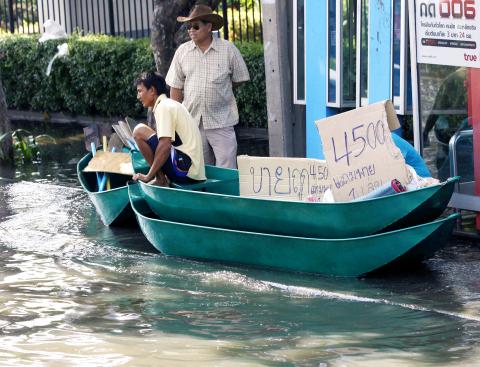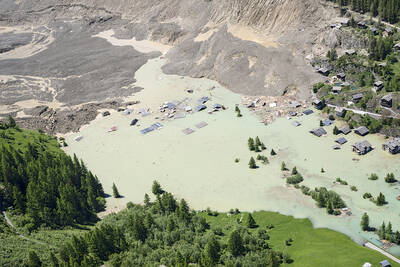The Thai capital, built on swampland, is slowly sinking and the floods currently besieging Bangkok could be merely a foretaste of a grim future as climate change makes its impact felt, experts say.
The low-lying metropolis lies about 30km north of the Gulf of Thailand, where various experts forecast that the sea level will rise by 19cm to 29cm by 2050 as a result of global warming.
Water levels would also increase in Bangkok’s main Chao Phraya River, which already regularly overflows.

Photo: Reuters
If no action is taken to protect the city, “in 50 years ... most of Bangkok will be below sea level,” said Anond Snidvongs, a climate change expert at the capital’s Chulalongkorn University.
However, global warming is not the only threat. The capital’s gradual sinking has also been blamed on years of aggressive groundwater extraction to meet the growing needs of the city’s factories and its 12 million inhabitants.
As a result, Bangkok was sinking by 10cm a year in the late 1970s, according to a study published last year by the World Bank, the Asian Development Bank (ADB) and the Japan Bank for International Cooperation.
That rate has since dropped to less than 1cm annually, they said, thanks to government measures to control groundwater pumping.
If those efforts continued, the report said, they hoped the subsidence rate could slow by another 10 percent each year.
However, Anond disputed their projections, saying Bangkok was still sinking at “an alarming rate” of 1cm to 3cm a year.
While scientists may argue over the exact figures, they agree about what lies ahead for the sprawling megacity.
“There is no going back. The city is not going to rise again,” the ADB’s lead climate change specialist, David McCauley, said.
Faced with the combined threats of land subsidence and rising temperatures and sea levels, the World Bank has predicted that Bangkok’s flood risk will increase four-fold by 2050.
And the Organisation for Economic Co-operation and Development has classified the Thai capital among the 10 cities in the world facing the biggest potential impact from coastal flooding by 2070.
For now, Bangkok is relying on a complex system of dykes, canals, locks and pumping stations to keep the rising waters at bay.
However, the flood protection efforts failed to prevent an onslaught of run-off water from the north from swamping at least one-fifth of the capital.
The murky floodwaters, triggered by three months of heavy monsoon rains, are edging in on Bangkok’s glitzy downtown area, threatening luxury hotels, office buildings and shopping malls.
Rapid urbanization is one reason why the inundations are affecting the sprawling city so badly, according to experts.
As the area that needs flood protection gets larger and more built-up, the water “has fewer places to go,” said Francois Molle, a water management expert at France’s Institut de Recherche pour le Developpement.
Molle said that in the long term, Bangkok would eventually be under water.
“The only question is when,” he said.
Experts say Thai authorities must address the capital’s land use and planning challenges and consider relocating factories or industrial parks in flood-prone areas.
Or even moving the entire city.
“It may be appropriate for the people who want to be dry 24 hours a day, 365 days a year, to be setting up a new city,” Anond said.
“We do have areas where we can develop a new city that would be completely dry. There’s a lot of land in this country,” he said.
It may sound like a drastic scenario, but there is little doubt that Bangkok will have to act if it wants to avoid the fate of the fabled sunken city of Atlantis.
“To remain where it is, the city will need better protection,” said Robert Nicholls, a professor of coastal engineering at Britain’s University of Southampton.
He said he expected Bangkok’s current flood misery to “trigger massive investment in defenses over the next 10 to 20 years.”
Dealing with the phenomenon will be expensive elsewhere too. Across the Asia-Pacific region the ADB has estimated it will cost a minimum of US$10 billion a year to adapt to climate change.

The collapse of the Swiss Birch glacier serves as a chilling warning of the escalating dangers faced by communities worldwide living under the shadow of fragile ice, particularly in Asia, experts said. Footage of the collapse on Wednesday showed a huge cloud of ice and rubble hurtling down the mountainside into the hamlet of Blatten. Swiss Development Cooperation disaster risk reduction adviser Ali Neumann said that while the role of climate change in the case of Blatten “still needs to be investigated,” the wider impacts were clear on the cryosphere — the part of the world covered by frozen water. “Climate change and

Poland is set to hold a presidential runoff election today between two candidates offering starkly different visions for the country’s future. The winner would succeed Polish President Andrzej Duda, a conservative who is finishing his second and final term. The outcome would determine whether Poland embraces a nationalist populist trajectory or pivots more fully toward liberal, pro-European policies. An exit poll by Ipsos would be released when polls close today at 9pm local time, with a margin of error of plus or minus 2 percentage points. Final results are expected tomorrow. Whoever wins can be expected to either help or hinder the

DENIAL: Musk said that the ‘New York Times was lying their ass off,’ after it reported he used so much drugs that he developed bladder problems Elon Musk on Saturday denied a report that he used ketamine and other drugs extensively last year on the US presidential campaign trail. The New York Times on Friday reported that the billionaire adviser to US President Donald Trump used so much ketamine, a powerful anesthetic, that he developed bladder problems. The newspaper said the world’s richest person also took ecstasy and mushrooms, and traveled with a pill box last year, adding that it was not known whether Musk also took drugs while heading the so-called US Department of Government Efficiency (DOGE) after Trump took power in January. In a

It turns out that looming collision between our Milky Way and Andromeda galaxies might not happen after all. Astronomers on Monday said that the probability of the two spiral galaxies colliding is less than previously thought, with a 50-50 chance within the next 10 billion years. That is essentially a coin flip, but still better odds than previous estimates and farther out in time. “As it stands, proclamations of the impending demise of our galaxy seem greatly exaggerated,” the Finnish-led team wrote in a study appearing in Nature Astronomy. While good news for the Milky Way galaxy, the latest forecast might be moot